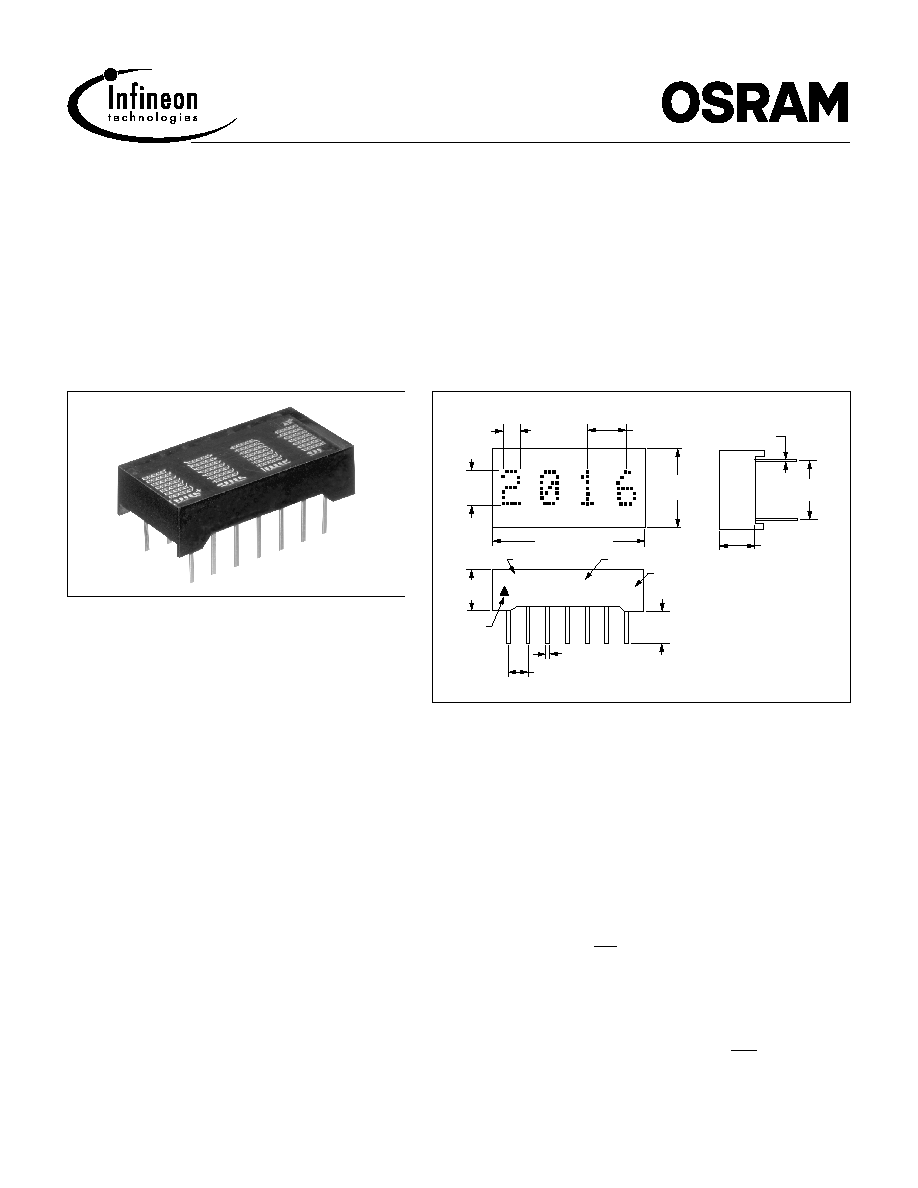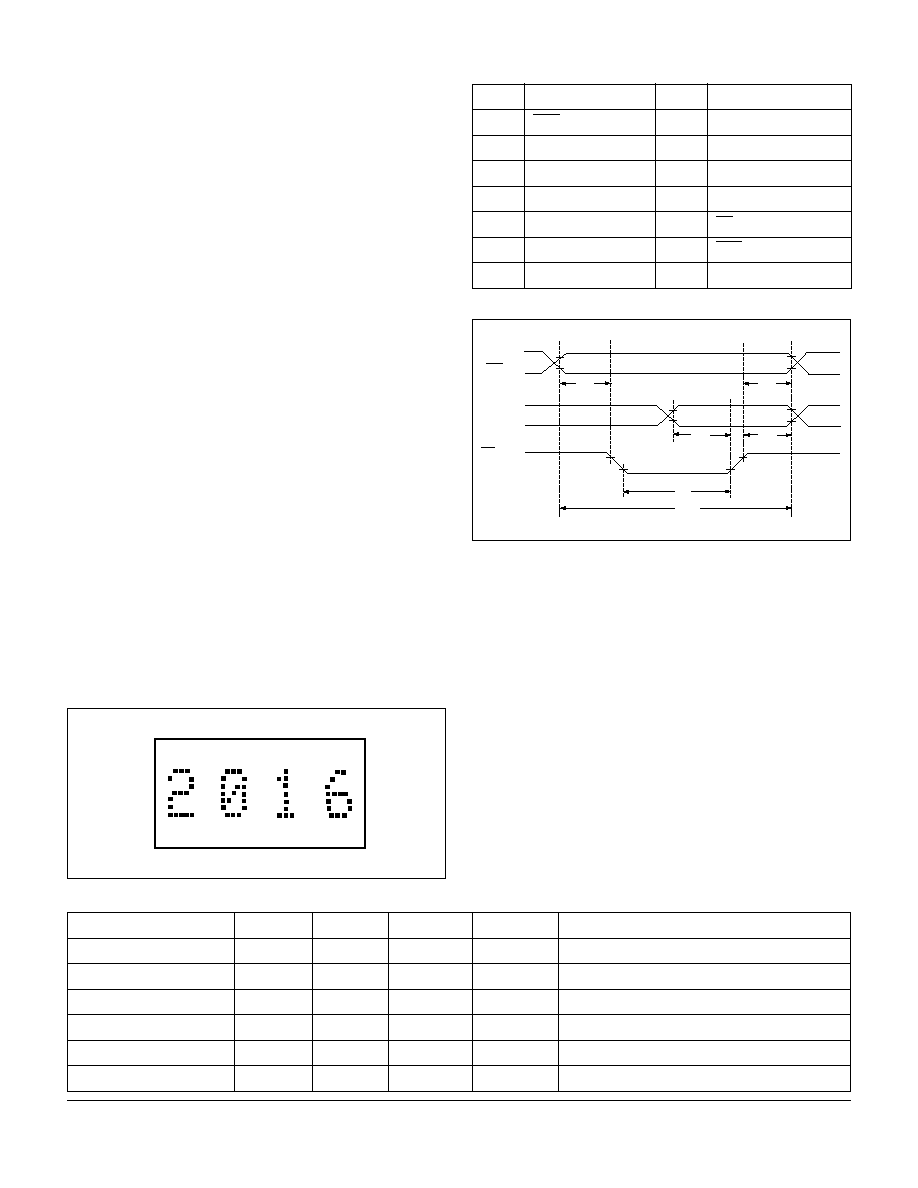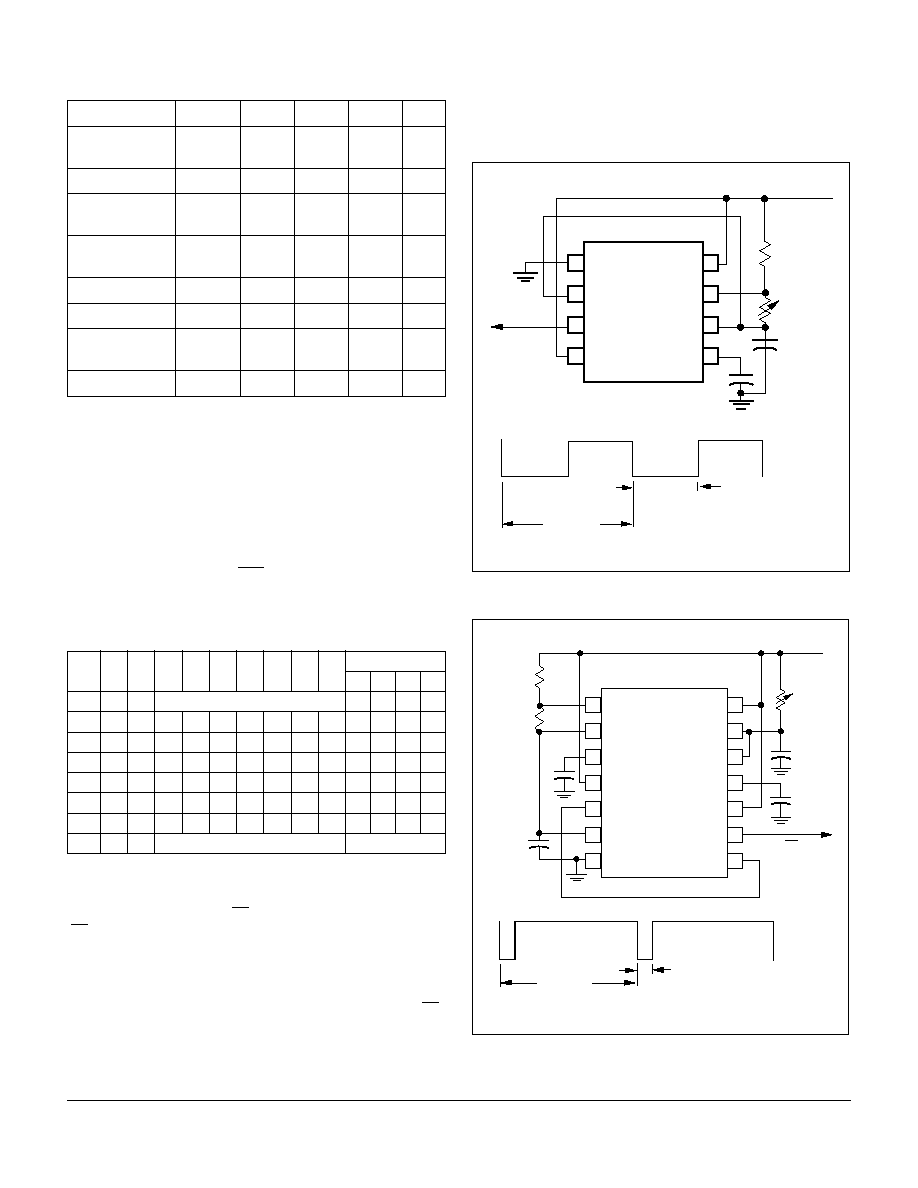
2000 Infineon Technologies Corp. · Optoelectronics Division · San Jose, CA
www.infineon.com/opto · 1-888-Infineon (1-888-463-4636)
OSRAM Opto Semiconductors GmbH & Co. OHG · Regensburg, Germany
www.osram-os.com · +49-941-202-7178
1
March 23, 2000-01
RED
SLR2016
HIGH EFFICIENCY RED
SLO2016
GREEN
SLG2016
YELLOW
SLY2016
X/Y Stackable 0.180" 4-Digit 5 x 7 Dot Matrix
Alphanumeric Intelligent Display
®
Devices
with Memory/Decoder/Driver
FEATURES
· Very Close Multi-line Spacing, 0.4" Centers
· 0.180" 5 x 7 Dot Matrix Characters
· 128 Special ASCII Characters for English,
German, Italian, Swedish, Danish, and
Norwegian Languages
· Wide Viewing Angle: X axis 50
°
Maximum,
Y Axis ±75
°
Maximum
· Fast Access Time, 110 ns at 25
°
C
· Full Size Display for Stationary Equipment
· Built-in Memory
· Built-in Character Generator
· Built-in Multiplex and LED Drive Circuitry
· Direct Access to Each Digit Independently and
Asynchronously
· Clear Function that Clears Character Memory
· True Blanking for Intensity Dimming Applications
· End-stackable, 4-Character Package
· Intensity Coded for Display Uniformity
· Extended Operating Temperature Range: 40
°
C to
+85
°
C
· Superior ESD Immunity
· 100% Burned-in and Tested
· Wave Solderable
· TTL Compatible over Operating Temperature Range
See Appnotes 18, 19, 22, and 23 at www.infineon.com/
opto for additional information.
DESCRIPTION
The SLR/SLO/SLG/SLY2016 is a four digit 5 x 7 dot matrix display
module with a built-in CMOS integrated circuit. This display is X/Y
stackable.
The integrated circuit contains memory, a 128 ASCII ROM decoder,
multiplexing circuitry and drivers. Data entry is asynchronous. A dis-
play system can be built using any number of SLR/SLO/SLG/SLY2016
since each digit can be addressed independently and will continue to
display the character last stored until replaced by another.
System interconnection is very straightforward. Two address bits (A0,
A1) are normally connected to the like-named inputs of all displays in
the system.
Data lines are connected to all SLR/SLO/SLG/SLY2016s directly and in
parallel as is the write line (WR). The display will then behave as a
write-only memory.
The SLR/SLO/SLG/SLY2016 has several features superior to competi-
tive devices. 100% burn-in processing insures that the SLR/SLO/SLG/
SLY2016 will function in more stressful assembly and use environ-
ments. True "blanking" allows the designer to dim the display for
more flexibility of display presentation. Finally the CLR clear function
will clear the ASCII character RAM.
0.100
(2.54)
0.197 (3 pl.)
(5.00)
0.400
±
.015
(10.16
±
.38)
0.018 (.46)
0.180
(4.57)
0.784 (19.91)
EIA Date Code
Luminous Intensity Code
Pin 1
Indicator
.100 (2.54)
Non-cumulative (12 pl.)
0.200
(5.08)
Part Number
XXYY
SLX2016
OSRAM
Z
0.150
(3.81)
0.012 (.3)
±
.002 (.05)
0.300
±
.020
(7.62
±
.51)
0.160
±
.020
(4.06
±
.51)
Tolerance:
±
.010 (.25)
Dimensions in inches (mm)

2000 Infineon Technologies Corp. · Optoelectronics Division · San Jose, CA
SLR/SLO/SLG/SLY2016
www.infineon.com/opto · 1-888-Infineon (1-888-463-4636)
OSRAM Opto Semiconductors GmbH & Co. OHG · Regensburg, Germany
www.osram-os.com · +49-941-202-7178
2
March 23, 2000-01
DESCRIPTION
(continued)
The character set consists of 128 special ASCII characters for
English, German, Italian, Swedish, Danish, and Norwegian.
All products are 100% burned-in and tested, then subjected to
out-going AQL's of .25% for brightness matching, visual align-
ment and dimensions, .065% for electrical and functional.
Maximum Ratings
DC Supply Voltage .........................................0.5 V to +7.0 Vdc
Input Voltage, Respect to GND
(all inputs)............................................0.5 V to
V
CC
+0.5 Vdc
Operating Temperature ..................................... 40
°
C to +85
°
C
Storage Temperature ....................................... 40
°
C to +100
°
C
Relative Humidity at 85
°
C ...................................................85%
Maximum Solder Temperature, 0.063" (1.59 mm)
below Seating Plane, t<5.0 s ........................................ 260
°
C
Optical Characteristics
Spectral Peak Wavelength
Red ...................................................................... 660 nm typ.
HER ..................................................................... 635 nm typ.
Green .................................................................. 565 nm typ.
Yellow .................................................................. 585 nm typ.
Digit Height......................................................0.180" (4.57 mm)
Time Averaged Luminous Intensity
(1)
at
V
CC
=5.0 V
Red................................................................50
µ
cd/LED min.
HER/Yellow ...................................................60
µ
cd/LED min.
Green ............................................................75
µ
cd/LED min.
LED to LED Intensity Matching,
V
CC
=5.0 V ........... 1.8:1.0 max.
Viewing Angle (off normal axis)
Horizontal ...............................................................±50
°
max.
Vertical ...................................................................±75
°
max.
Note:
1)
Peak luminous intensity values can be calculated by multiplying
these values by 7.
Figure 1. Top View
DC Characteristics at 25
°
C
Parameters
Min.
Typ.
Max.
Units
Conditions
V
CC
4.5
5.0
5.5
V
--
I
CC
Blank
--
2.3
3.0
mA
V
CC
=5.0 V
I
CC
(80 dots on)
--
80
105
mA
V
CC
=5.0 V
V
IL
(all inputs)
--
--
0.8
V
4.5 V <
V
CC
<5.5 V
V
IH
(all inputs)
2.0
--
--
V
4.5 V <
V
CC
<5.5 V
I
IL
(all inputs)
25
--
100
µ
A
4.5 V <
V
CC
<5.5 V,
V
IN
=0.8 V
Digit3 Digit2 Digit1 Digit0
1 2 3 4 5 6 7
14 13 12 11 10 9 8
Pin Function
Figure 2. Timing Characteristics--Write Cycle Waveforms
Pin
Function
Pin
Function
1
WR Write
8
D3 Data
2
A1 Digit Select
9
D4 Data
3
A0 Digit Select
10
D5 Data
4
V
CC
11
D6 Data
5
D0 Data
12
BL Display Blank
6
D1 Data
13
CLR Clear
7
D2 Data
14
GND
T
AS
T
DH
T
AH
T
DS
T
ACC
T
W
WR
CLR
A0 A1
D0 D6
2.0 V
0.8 V
2.0 V
0.8 V
2.0 V
0.8 V

2000 Infineon Technologies Corp. · Optoelectronics Division · San Jose, CA
SLR/SLO/SLG/SLY2016
www.infineon.com/opto · 1-888-Infineon (1-888-463-4636)
OSRAM Opto Semiconductors GmbH & Co. OHG · Regensburg, Germany
www.osram-os.com · +49-941-202-7178
3
March 23, 2000-01
AC Characteristics
(guaranteed minimum timing
parameters at
V
CC
=5.0 V ±0.5 V)
Note:
1)
T
ACC
=Set Up Time + Write Time + Hold Time
Loading Data
The desired data code (D0D6) and digit address (A0, A1) must
be held stable during the write cycle for storing new data.
Data entry may be asynchronous. Digit 0 is defined as right
hand digit with A1=A2=0.`
Clearing the entire internal four-digit memory can be accom-
plished by holding the clear (CLR) low for 1.0 msec minimum.
The clear function will clear the ASCII RAM. Loading an illegal
data code will display a blank.
Typical Loading State Table
Display Blanking
Blank the display by loading a blank or space into each digit of
the display or by using the (BL) display blank input. Setting the
(BL) input low does not affect the contents of data memory.
A flashing circuit can easily be constructed using a 555 as table
multivibrator. Figure 3 illustrates a circuit in which varying R1
(100K~10K) will have a flash rate of 1.0 Hz~10 Hz.
The display can be dimmed by pulse width modulating the (BL)
at a frequency sufficiently fast to not interfere with the internal
clock. The dimming signal frequency should be 2.5 kHz or
higher. Dimming the display also reduces power consumption.
Parameter
Symbol
40
°
C
+25
°
C
+85
°
C
Unit
Address Set
Up Time
T
AS
10
10
10
ns
Write Time
T
W
60
70
90
ns
Data Set Up
Time
T
DS
20
30
50
ns
Address Hold
Time
T
AH
20
30
40
ns
Data Hold Time
T
DH
20
30
40
ns
Access Time
T
ACC
(1)
90
110
140
ns
Clear Disable
Time
T
CLRD
1.0
1.0
1.0
µ
s
Clear Time
T
CLR
1.0
1.0
1.0
ms
WR
A1 A0 D6 D5 D4 D3 D2 D1 D0 Digit
3
2
1
0
H
previously loaded display
G
R
E
Y
L
L
L
H
L
L
L
H
L
H
G
R
E
E
L
L
H
H
L
H
L
H
L
H
G
R
U
E
L
H
L
H
L
L
H
H
L
L
G
L
U
E
L
H
H
H
L
L
L
L
H
L
B
L
U
E
L
L
H
H
L
L
L
H
L
H
B
L
E
E
L
L
L
H
L
H
L
H
H
H
B
L
E
W
L
X
X
see character code
see char. set
An example of a simple dimming circuit using a 556 is illus-
trated in Figure 4. Adjusting potentiometer R3 will dim the dis-
play by changing the blanking pulse duty cycle.
Figure 3. Flashing Circuit Using a 555 and Flashing
(Blanking) Timing
Figure 4. Dimming Circuit Using a 556 and Dimming
(Blanking) Timing
Blanking Pulse Width
50% Duty Factor
500 ms
2 Hz Blanking Frequency
1
0
~
~
~
~
555
Timer
R1
4.7 K
R2
100 K
C4
0.01
µ
F
C3
10
µ
F
VCC=5.0 V
To BL
Pin on
Display
1
2
3
4
8
7
6
5
C3
1000 pF
1
2
3
4
5
6
7
14
13
12
11
10
9
8
556
Dual Timer
R2
47 K
R1
200
C1
4700 pF
C4
0.01
µ
F
R3
500 K
VCC=5.0 V
Dimming (Blanking)
Control
C2
0.01
µ
F
To BL Pin
on Display
1
0
200
µ
s
Blanking Pulse Width
4
µ
s min., 196
µ
s max.
5 KHz Blanking Frequency
~
~
~
~

2000 Infineon Technologies Corp. · Optoelectronics Division · San Jose, CA
SLR/SLO/SLG/SLY2016
www.infineon.com/opto · 1-888-Infineon (1-888-463-4636)
OSRAM Opto Semiconductors GmbH & Co. OHG · Regensburg, Germany
www.osram-os.com · +49-941-202-7178
4
March 23, 2000-01
Figure 5. Character Set
Figure 6. Block Diagram
ASCII
CODE
D0
D1
D2
D3
0
0
0
0
0
1
0
0
0
1
0
1
0
0
2
1
1
0
0
3
0
0
1
0
4
1
0
1
0
5
0
1
1
0
6
1
1
1
0
7
0
0
0
1
8
1
0
0
1
9
0
1
0
1
A
1
1
0
1
B
0
0
1
1
C
1
0
1
1
D
0
1
1
1
E
1
1
1
1
F
0
0
0
0
1
1
1
1
0
0
1
1
0
0
1
1
0
1
0
1
0
1
0
1
0
1
2
3
4
5
6
7
D6 D5 D4 HEX
Notes:
1. High=1 level
2. Low=0 level
3. Upon power up, the device
will initialize in a random state.
3 2 1 0
Display
Rows 0 to 6
Timing and Control Logic
Row Control Logic
&
Row Drivers
Row Decoder
RAM Read Logic
RAM
Memory
ROM
7 Bit ASCII Code
Column Data
D6
D5
D4
D3
D2
D1
D0
128 X 7 Bit ASCII
Character Decode
(4.48K Bits)
BL
CLR
OSC
128
Counter
7
Counter
Display Output Logic
Latches
Column Decoder
WR
A0
A1
Write
Address
Decoder
4 X 7 Bit
Columns 0 to 19
Address
Bus
÷
÷

2000 Infineon Technologies Corp. · Optoelectronics Division · San Jose, CA
SLR/SLO/SLG/SLY2016
www.infineon.com/opto · 1-888-Infineon (1-888-463-4636)
OSRAM Opto Semiconductors GmbH & Co. OHG · Regensburg, Germany
www.osram-os.com · +49-941-202-7178
5
March 23, 2000-01
Design Considerations
For details on design and applications of the SLX2016 in multi-
ple display systems, refer to Appnote 15 at www.infineon.com/
opto.
Electrical & Mechanical Considerations
Voltage Transient Suppression
We recommend that the same power supply be used for the
display and the components that interface with the display to
avoid logic inputs higher than
V
CC
. Additionally, the LEDs may
cause transients in the power supply line while they change
display states. The common practice is to place .01 mF capaci-
tors close to the displays across
V
CC
and GND, one for each
display, and one 10
µ
F capacitor for every second display.
ESD Protection
The CMOS IC of the SLX2016 is resistant to ESD damage and
capable of withstanding discharges less than 2.0 kV. However,
take all the standard precautions, normal for CMOS compo-
nents. These include properly grounding personnel, tools,
tables, and transport carriers that come in contact with
unshielded parts. If these conditions are not, or cannot be met,
keep the leads of the device shorted together or the parts in
anti-static packaging.
Soldering Considerations
The SLX2016 can be hand soldered with SN63 solder using a
grounded iron set to 260
°
C.
Wave soldering is also possible following these conditions: Pre-
heat that does not exceed 93
°
C on the solder side of the PC
board or a package surface temperature of 85
°
C. Water soluble
organic acid flux (except carboxylic acid) or rosin-based RMA
flux without alcohol can be used.
Wave temperature of 245
°
C ±5
°
C with a dwell between 1.5 sec.
to 3.0 sec. Exposure to the wave should not exceed tempera-
tures above 260
°
C for five seconds at 0.063" below the seating
plane. The packages should not be immersed in the wave.
Post Solder Cleaning Procedures
The least offensive cleaning solution is hot D.I. water (60
°
C) for
less than 15 minutes. Addition of mild saponifiers is accept-
able. Do not use commercial dishwasher detergents.
For faster cleaning, solvents may be used. Carefully select any
solvent as some may chemically attack the nylon package.
Maximum exposure should not exceed two minutes at ele-
vated temperatures. Acceptable solvents are TF (trichorotrifluo-
rethane), TA, 111 Trichloroethane, and unheated acetone.
Note:
Acceptable commercial solvents are: Basic TF, Arklone,
P. Genesolv, D. Genesolv DA, Blaco-Tron TF, Blaco-Tron TA,
and Freon TA.
Unacceptable solvents contain alcohol, methanol, methylene chlo-
ride, ethanol, TP35, TCM, TMC, TMS+, TE, or TES. Since many
commercial mixtures exist, contact a solvent vendor for chemical
composition information. Some major solvent manufacturers are:
Allied Chemical Corporation, Specialty Chemical Division, Morris-
town, NJ; Baron-Blakeslee, Chicago, IL; Dow Chemical, Midland,
MI; E.I. DuPont de Nemours & Co., Wilmington, DE.
For further information refer to Appnotes 18 and 19 at www.infineon.
com/opto.
An alternative to soldering and cleaning the display modules is
to use sockets. Standard pin DIP sockets .300" wide with .100"
centers work well for single displays. Multiple display assem-
blies are best handled by longer SIP sockets or DIP sockets
when available for uniform package alignment. Socket manu-
facturers are Aries Electronics, Inc., Frenchtown, NJ; Garry
Manufacturing, New Brunswick, NJ; Robinson-Nugent, New
Albany, IN; and Samtec Electronic Hardware, New Albany, IN.
For further information refer to Appnote 22 at www.infineon.com/
opto.
Optical Considerations
The .180" high characters of the SLX2016 gives readability up
to eight feet. Proper filter selection enhances readability over
this distance.
Filters enhance the contrast ratio between a lit LED and the charac-
ter background intensifying the discrimination of different charac-
ters.The only limitation is cost. Take into consideration the ambient
lighting environment for the best cost/benefit ratio for filters.
Incandescent (with almost no green) or fluorescent (with
almost no red) lights do not have the flat spectral response of
sunlight. Plastic band-pass filters are an inexpensive and effec-
tive way to strengthen contrast ratios.The SLR2016 is a stan-
dard red display and should be matched with long wavelength
pass filter in the 600 nm to 620 nm range.
The SLO2016 is a high efficiency red display and should be
matched with a long wavelength pass filter in the 470 nm to 590
nm range. The SLG/SLY2016 should be matched with a yellow-
green band-pass filter that peaks at 565 nm. For displays of multi-
ple colors, neutral density gray filters offer the best compromise.
Additional contrast enhancement is gained by shading the dis-
plays. Plastic band-pass filters with built-in louvers offer the
next step up in contrast improvement. Plastic filters can be
improved further with anti-reflective coatings to reduce glare.
The trade-off is fuzzy characters. Mounting the filters close to
the display reduces this effect. Take care not to overheat the
plastic filter by allowing for proper air flow.
Optimal filter enhancements are gained by using circular polar-
ized, anti-reflective, band-pass filters. Circular polarizing further
enhances contrast by reducing the light that travels through the
filter and reflects back off the display to less than 1%.
Several filter manufacturers supply quality filter materials.
Some of them are: Panelgraphic Corporation, W. Caldwell, NJ;
SGL Homalite, Wilmington, DE; 3M Company, Visual Products
Division, St. Paul, MN; Polaroid Corporation, Polarizer Division,
Cambridge, MA; Marks Polarized Corporation, Deer Park, NY,
Hoya Optics, Inc., Fremont, CA.
One last note on mounting filters: recessing displays and bezel
assemblies is an inexpensive way to provide a shading effect in
overhead lighting situations. Several Bezel manufacturers are:
R.M.F. Products, Batavia, IL; Nobex Components, Griffith Plas-
tic Corp., Burlingame, CA; Photo Chemical Products of Califor-
nia, Santa Monica, CA; I.E.E.-Atlas, Van Nuys, CA.
Refer to Appnote 23 at www.infineon.com/opto for further infor-
mation.




